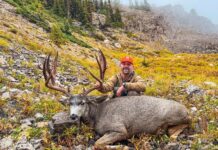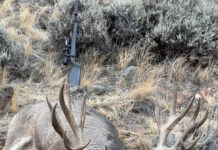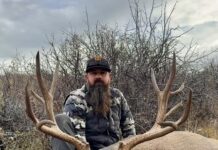
A few weeks back, I wrote about my personal application strategy in Arizona, Utah, Montana, and Wyoming. You can review that post here Application Strategy: Part I. I’ll pick up here with the remainder of Western States where I apply.
A few weeks back, I wrote about my personal application strategy in Arizona, Utah, Montana, and Wyoming. You can review that post here Application Strategy: Part I. I’ll pick up here with the remainder of Western States where I apply.
This same subject garnered the top posts on the Rok Blog last year, so I’m here to oblige those interested. My strategy is written from the perspective of a mule deer hunter who loves big deer but has limited funds. All application dates mentioned are for mule deer and may or may not coincide with deadlines for other big game species. Links to application websites can be accessed by clicking on the name of state.

Colorado: If you’ve followed my hunts these last few years, you know I really try to focus on the Centennial state. I typically apply for points then search for affordable landowner tags (to me, that rings in around a grand). I think the early archery and muzzleloader seasons offer a decent chance at a great buck if you scout, learn your country, and keep going back. Not coincidentally, my best buck last year came from Colorado, see: Live Hunt:Colorado
No matter the weapon, unless you have 9+ points, you won’t be in a great unit. No worries—many low-point units produce great bucks for the persistent hunter. While Colorado’s 3rd and 4th season rifle hunts get all the glory (and take all the points) don’t be afraid to hunt Colorado’s 2nd season in good units. The season runs nine days. If the weather cooperates, the late October dates can be good for a hunter who knows his territory.
Like Arizona, I also apply for elk points in Colorado, and have for nearly 20 years. With a true preference point system, it makes sense to apply for me, although I might be on oxygen by the time I finally decide to hunt elk. Colorado’s application deadline is April 1st.
New Mexico: I applied there for years, but when they started penalizing non-residents with higher fees and lower quotas (6% for non-guided hunters), I exercised my free-market choice and quit sending them money. I’m a long ways from the Enchanted state, so I’d have to draw a great hunt to expect to do well. A hard-working resident could still turn up some great bucks. With terrible odds for good deer hunts, it’s tough writing out a check to a state that doesn’t value my dollar. New Mexico requires the entire tag and license fee upfront. You’re refunded all of it if you don’t draw. As New Mexico doesn’t offer points, I can get in the game anytime I change my mind. Their application period closes March 19th.
Nevada: I consider the Silver State a top destination for big mule deer hunters. However, in a dozen years of scouting there and applying, I’ve yet to draw a tag. Nevada is good, if you can just get past the gatekeeper. I’m currently carrying seven points (you don’t have to buy the license every year to keep your points) but might bump that to eight this year. Nevada, like Arizona, requires purchase of a non-refundable license. She can get spendy in a hurry for a father of three, so I’m pretty careful. I apply for a variety of weapon choices across Nevada’s five application choices. I know the bucks are there if I can just get the tag. Nevada’s draw deadline is around April 15th.
Oregon: I applied for years in Oregon before I realized what a poor value for the non-resident dollar they are. With 5% non-resident quotas, often split with outfitters, I’d feel better watching my son flush a $100 down the toilet than giving Oregon money. If you are a resident—and you scout—you could still take a great buck. She’s got the genetics and a few bucks still growing old. One of my acquaintances recently took a 200″ buck out of a mediocre unit that he’d scouted and learned over the years. Oregon’s deadline is May 15th if you’re feeling lucky.
Idaho: My homestate offers some of the best genetics in the West but is managed mostly for opportunity, so big deer are tough to come by. However, every year with scouting, hunting hard, and a little faith, I turn up some top-end mule deer. See Live Hunt:Idaho for my latest. I find most of these bucks in OTC units. I apply for controlled hunts every year but have never drawn a really good one. I’ve been applying since I was 12 years old, never missing an application since about 1989. Idaho requires purchase of a non-refundable hunting license but offers no point system. I’d have a hard time talking a wage-earning non-resident into applying here unless he planned on hunting OTC if he didn’t draw. Idaho residents who are traveling out of state to hunt big deer are driving right by bucks they’d be happy with as they search for greener pastures.
If you ever want to kill a big deer, you have to focus and hunt enough days to give yourself a reasonable opportunity. I don’t believe you need to apply in all Western states to be successful. However, you need to create the opportunity to hunt up to thirty days of open season a year in country that holds at least a few big deer. Do that and you’re no longer relying on luck to kill a great mule deer.




















Just a tip for Oregon. It is not a good state for non-res rifle hunters, but can be a good value for the bow hunter. Archery deer, elk, and fall bear run concurent and almost the entire state is general season OTC for all three species. However, the best archery opportunities for elk in the NE part of Oregon are all controlled draw, and the only way you can hunt deer there is if you also have an archery elk tag. If interested in Oregon bow hunting, apply for the Weneha, Mt. Emily Elk bow tags. If you ever get lucky enough to draw (not likely for a long time), you have a good shot at a 375″ bull and nice deer….so get the points. When you don’t draw, buy your OTC elk, deer, and bear tags and there many good public land spots where you can hunt all three during the entire season. Mountain lion is also a general tag for non-res. Its a good option if you have to schedule your vacation/hunting in advance, and need to know you will be able to get a tag.
Hey Chad, very helpful to have the insight of an Oregon resident- thank you!
Comments are closed.